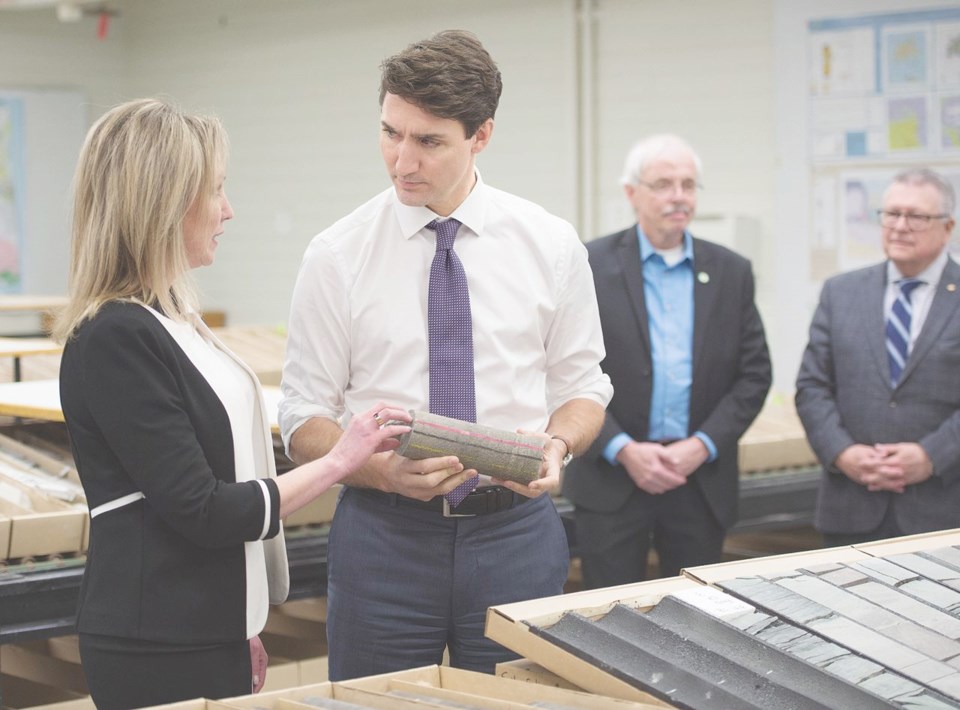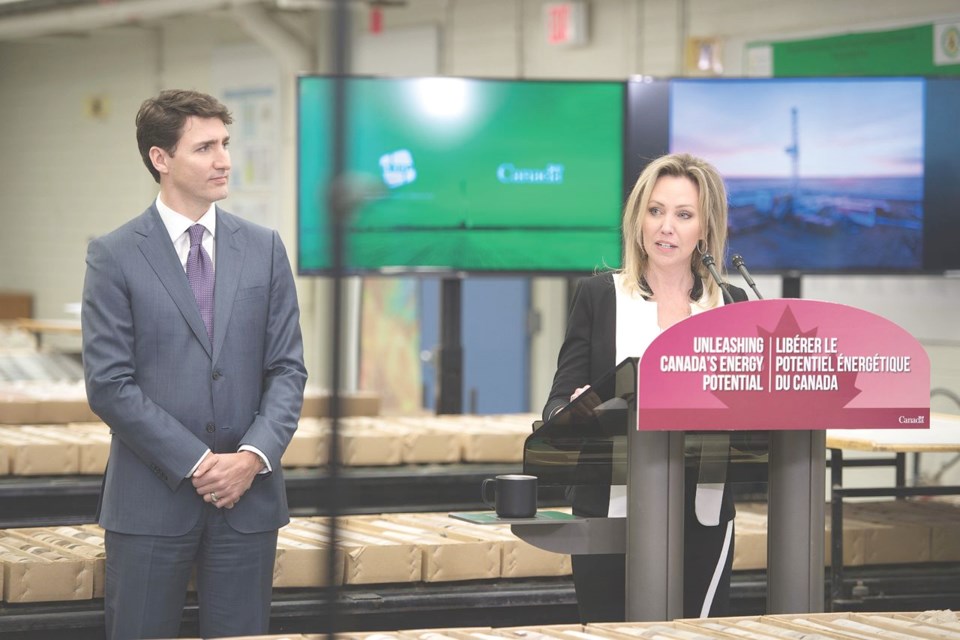Handing Prime Minister Justin Trudeau a piece of core, Kirsten Marcia explained to him that it was from the deepest well in Saskatchewan, 3,530 metres down, and it had not seen the surface for around a half billion years. She also explained her intentions of producing green, emissions-free electrical power from it.
“It’s full of water, and three-and-a-half kilometres in depth. When we drill into this, that water actually flows right to surface,” she told him, in explaining some of the science behind the geothermal electrical power project. Marcia, a geologist herself, has been working on since 2010.
It was an enormous day for Marcia, originally from Estevan, and her team with Deep Earth Energy Production (DEEP) Corp. Trudeau had been in Regina the night before for a townhall at the University of Regina. Marcia is the president and CEO of DEEP.
“We’re excited about geothermal in Saskatchewan. Of course, it’s an obvious place for geothermal, with all the volcanoes you have here,” Trudeau joked after he put down the core. “Recognizing the extraordinary potential this is is very exciting,” he said, once the chuckles died down.
He was then shown maps indicating the geothermal potential in southeast Saskatchewan and was able to take a look through a microscope at some of that core.
Trudeau’s presence that morning was to announce $25.6 million in federal funding for DEEP’s geothermal project, location within sight of the U.S. border, south of Torquay.
The federal funding makes up approximately half of the funds needed to complete this, the second phase of the project, which includes building a pilot plant that would be supplying five megawatts of electricity to the power grid in about 2 1/2 years. Its initial well was spudded in mid-November and completed in late December. That included the retrieval of over 200 metres of core, recovered across the targeted reservoir.
It was some of that core DEEP had on display to show the prime minister; the deepest, oldest core ever retrieved in Saskatchewan. It was deeper by over 100 metres than that from the Aquistore wells near Boundary Dam Power Station.
Drill stem test (DST) results were positive, indicating reservoir pressure and permeability that exceeds the minimum threshold for project feasibility. The well was completed with a slotted production liner, in preparation for the second phase of the pilot project which includes a production flow and build up test this spring.
Federal funding was a key component in DEEP being able to drill that first well at Torquay. The vertical well, managed by Frontier Project Solutions and drilled by Horizon Drilling, reached its target total depth of 3,530 metres on December 16, 2018. Several more are expected to be drilled, in “doublets” of injectors and producers.
But they’re not producing oil. They’re producing hot, salty water. Heat recovered from that brine will use the organic Rankine cycle to generate electricity. Marcia said the results exceeded expectations and that they had found water 125 C in temperature.
The next steps for the project include the drilling and coring of a Mannville injection well on the same location before spring. During production testing operations, produced brine from the source well will be injected and disposed into the injection well, enabling a production/injection doublet.
Further geothermal parameters including corroboration of the initial DST data with confirmation of pressure, temperature and reservoir permeability will be acquired during this next step which includes a longer term (30-day) injection and production flow and build up test.
“In effect, we’re supporting DEEP, as they mine natural heat to generate clean, renewable energy that will help power Saskatchewan’s homes and businesses,” Trudeau said.
“Once the proposed facility is done, the electricity produced will be able to power 5,000 homes, all the while taking the yearly pollution of 7,400 cars out of the atmosphere. And if all that sounds cutting edge, that’s because it is.
“DEEP’s plant will be Canada’s first ever geothermal power plant. The federal government contributed $1.5 million to test and launch this project, we knew it would be just the start of some incredible work being done, right here in Saskatchewan.”
He acknowledged the DEEP team and Marcia, as a “clean-energy trailblazer and an outstanding lady.”
“This project is expected to create 100 jobs during construction, providing more people with good employment and opportunities,” he added.
“Whether we’re supporting sustainable infrastructure, or putting a price on the pollution that causes climate change, while returning all the money collected back to Canadians, our government is committed to doing our part to build a better future for everyone,” Trudeau said.

Marcia said, “The funding announced today is critical for the success of this first geothermal power project. It’s funding like this, paired with equity investments from Canadians, that helps launch new, innovative, clean energy projects that will reduce our greenhouse gas emissions and create jobs.”
She thanked the Government of Canada and Natural Resources Canada for the funding. She also thanked SaskPower, the Government of Saskatchewan, and DEEP’s investors, all of whom have also contributed.
“What I find really unique about this project is that we are using Canada’s world-class oil and gas technology, and unleashing it for the first time, ever, on a renewable energy resource. Taking it one step further, I find it interesting that we wouldn’t even know this renewable energy resource existed, 3.5 kilometres beneath us, if it weren’t for the oil and gas industry doing their exploration.
“At our location, there isn’t any hot springs or any geysers. It’s just wide-open farmland. It took oil exploration to discover this geothermal resources.”
She reported the first well has been drilled west of Estevan, and it has exceeded expectations. “We are going to create clean, renewable power with it, emission-free and sustainable.”
“Successfully drilling and validating the resource potential is the biggest achievement this project has seen to date.”
In addition to federal funding, DEEP has also received money from SaskPower and Innovation Saskatchewan, in addition to its private investors. When completed, it will be the first geothermal power project in the country.
Representing the provincial government, Tina Beaudry-Mellor, Saskatchewan Minister of Innovation, said, “One of the things I’ve heard is the oil industry played a very important role in helping this project advance, which I think was really great to hear.”
In addition to its investment, SaskPower has committed to buy the electricity eventually produced by the project.
The backdrop of the announcement was the Saskatchewan Subsurface Geological Laboratory, or core lab, in Regina, the repository for all core collected in this province since it opened over 60 years ago.




